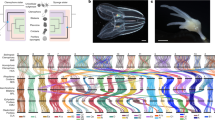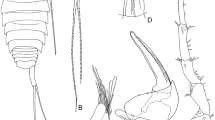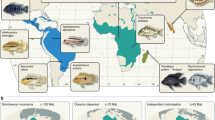Abstract
Tunicates or urochordates (appendicularians, salps and sea squirts), cephalochordates (lancelets) and vertebrates (including lamprey and hagfish) constitute the three extant groups of chordate animals. Traditionally, cephalochordates are considered as the closest living relatives of vertebrates, with tunicates representing the earliest chordate lineage1,2. This view is mainly justified by overall morphological similarities and an apparently increased complexity in cephalochordates and vertebrates relative to tunicates2. Despite their critical importance for understanding the origins of vertebrates3, phylogenetic studies of chordate relationships have provided equivocal results4,5,6,7. Taking advantage of the genome sequencing of the appendicularian Oikopleura dioica, we assembled a phylogenomic data set of 146 nuclear genes (33,800 unambiguously aligned amino acids) from 14 deuterostomes and 24 other slowly evolving species as an outgroup. Here we show that phylogenetic analyses of this data set provide compelling evidence that tunicates, and not cephalochordates, represent the closest living relatives of vertebrates. Chordate monophyly remains uncertain because cephalochordates, albeit with a non-significant statistical support, surprisingly grouped with echinoderms, a hypothesis that needs to be tested with additional data. This new phylogenetic scheme prompts a reappraisal of both morphological and palaeontological data and has important implications for the interpretation of developmental and genomic studies in which tunicates and cephalochordates are used as model animals.
This is a preview of subscription content, access via your institution
Access options
Subscribe to this journal
Receive 51 print issues and online access
$199.00 per year
only $3.90 per issue
Buy this article
- Purchase on Springer Link
- Instant access to full article PDF
Prices may be subject to local taxes which are calculated during checkout

Similar content being viewed by others
References
Schaeffer, B. Deuterostome monophyly and phylogeny. Evol. Biol. 21, 179–235 (1987)
Rowe, T. in Assembling the Tree of Life (eds Cracraft, J. & Donoghue, M. J.) 384–409 (Oxford Univ. Press, Oxford, 2004)
Gee, H. Before the Backbone: Views on the Origin of the Vertebrates (Chapman & Hall, London, 1996)
Zrzavy, J., Mihulka, S., Kepka, P., Bezdek, A. & Tietz, D. Phylogeny of the Metazoa based on morphological and 18S ribosomal DNA evidence. Cladistics 14, 249–285 (1998)
Winchell, C. J., Sullivan, J., Cameron, C. B., Swalla, B. J. & Mallatt, J. Evaluating hypotheses of deuterostome phylogeny and chordate evolution with new LSU and SSU ribosomal DNA data. Mol. Biol. Evol. 19, 762–776 (2002)
Blair, J. E. & Hedges, S. B. Molecular phylogeny and divergence times of deuterostome animals. Mol. Biol. Evol. 22, 2275–2284 (2005)
Philippe, H., Lartillot, N. & Brinkmann, H. Multigene analyses of bilaterian animals corroborate the monophyly of ecdysozoa, lophotrochozoa, and protostomia. Mol. Biol. Evol. 22, 1246–1253 (2005)
Delsuc, F., Brinkmann, H. & Philippe, H. Phylogenomics and the reconstruction of the tree of life. Nature Rev. Genet. 6, 361–375 (2005)
Gee, H. in Major Events in Early Vertebrate Evolution: Palaeontology, Phylogeny, Genetics, and Development (ed. Ahlberg, P. E.) 1–14 (Taylor and Francis, London, 2001)
Jefferies, R. P. S. in Biological Asymmetry and Handedness (eds Bock, G. R. & Marsh, J.) 94–127 (Wiley, Chichester, 1991)
Oda, H., Akiyama-Oda, Y. & Zhang, S. Two classic cadherin-related molecules with no cadherin extracellular repeats in the cephalochordate amphioxus: distinct adhesive specificities and possible involvement in the development of multicell-layered structures. J. Cell Sci. 117, 2757–2767 (2004)
Felsenstein, J. Inferring Phylogenies (Sinauer, Sunderland, Massachusetts, 2004)
Shimodaira, H. & Hasegawa, M. CONSEL: for assessing the confidence of phylogenetic tree selection. Bioinformatics 17, 1246–1247 (2001)
Felsenstein, J. Cases in which parsimony or compatibility methods will be positively misleading. Syst. Zool. 27, 401–410 (1978)
Yokobori, S., Oshima, T. & Wada, H. Complete nucleotide sequence of the mitochondrial genome of Doliolum nationalis with implications for evolution of urochordates. Mol. Phylogenet. Evol. 34, 273–283 (2005)
Ruiz-Trillo, I., Riutort, M., Fourcade, H. M., Baguna, J. & Boore, J. L. Mitochondrial genome data support the basal position of Acoelomorpha and the polyphyly of the Platyhelminthes. Mol. Phylogenet. Evol. 33, 321–332 (2004)
Conway Morris, S. The Cambrian “explosion”: slow-fuse or megatonnage? Proc. Natl Acad. Sci. USA 97, 4426–4429 (2000)
Bourlat, S. J., Nielsen, C., Lockyer, A. E., Littlewood, D. T. & Telford, M. J. Xenoturbella is a deuterostome that eats molluscs. Nature 424, 925–928 (2003)
Jefferies, R. P. S. The Ancestry of the Vertebrates (Cambridge Univ. Press, London, 1986)
Peterson, K. J. A phylogenetic test of the calcichordate scenario. Lethaia 28, 25–38 (1995)
Jefferies, R. P. S. A defence of the calcichordates. Lethaia 30, 1–10 (1997)
Ruppert, E. E. Key characters uniting hemichordates and chordates: homologies or homoplasies? Can. J. Zool. 83, 8–23 (2005)
Stone, J. R. & Hall, B. K. Latent homologues for the neural crest as an evolutionary novelty. Evol. Dev. 6, 123–129 (2004)
Jeffery, W. R., Strickler, A. G. & Yamamoto, Y. Migratory neural crest-like cells form body pigmentation in a urochordate embryo. Nature 431, 696–699 (2004)
Seo, H. C. et al. Hox cluster disintegration with persistent anteroposterior order of expression in Oikopleura dioica. Nature 431, 67–71 (2004)
Edvardsen, R. B. et al. Remodelling of the homeobox gene complement in the tunicate Oikopleura dioica. Curr. Biol. 15, R12–R13 (2005)
Holland, L. Z., Laudet, V. & Schubert, M. The chordate amphioxus: an emerging model organism for developmental biology. Cell. Mol. Life Sci. 61, 2290–2308 (2004)
Swofford, D. L. PAUP*: Phylogenetic Analyses Using Parsimony and Other Methods (Sinauer, Sunderland, Massachusetts, 2000)
Schmidt, H. A., Strimmer, K., Vingron, M. & von Haeseler, A. TREE-PUZZLE: maximum likelihood phylogenetic analysis using quartets and parallel computing. Bioinformatics 18, 502–504 (2002)
Yang, Z. PAML: a program package for phylogenetic analysis by maximum likelihood. Comput. Appl. Biosci. 13, 555–556 (1997)
Acknowledgements
We thank S. Conway Morris, R. P. S. Jefferies, W. R. Jeffery and J. Mallatt for suggestions, and N. Lartillot and N. Rodrigue for critical readings of early versions of the manuscript. Oikopleura genome data were generated at Génoscope Evry (France) with material and co-funding from the Sars International Centre. We are grateful to P. Wincker and the Génoscope team. We gratefully acknowledge the financial support provided by Génome Québec, the Canadian Research Chair and the Université de Montréal, and the Réseau Québecois de Calcul de Haute Performance for computational resources. Author Contributions H.P. conceived the study. D.C. contributed sequence data from the Oikopleura genome project. F.D., H.B. and H.P. assembled the data set and performed phylogenetic analyses. F.D. wrote the first draft of the manuscript and all authors contributed to the writing of its final version.
Author information
Authors and Affiliations
Corresponding author
Ethics declarations
Competing interests
Reprints and permissions information is available at npg.nature.com/reprintsandpermissions. The authors declare no competing financial interests.
Supplementary information
Supplementary methods
This file describes the protocol used to assemble the genomic data. More details on the phylogenetic analyses are also provided with investigations of the effects of taxon sampling, compositional bias and heterotachy on tree reconstruction.
Supplementary Table 1
This table provides the list of all 146 gene names and the number of amino acid positions conserved for each gene alignment.
Supplementary Table 2
This table summarizes the amount and occurrence of missing data per taxa in the complete dataset.
Supplementary Figure 1
This figure presents the most parsimonious tree obtained with Oikopleura dioica used as the single representative of tunicates.
Supplementary Figure 2
This figure shows the maximum likelihood tree obtained with a reduced dataset using Oikopleura as the single representative of tunicates.
Supplementary Figure 3
This figure presents a principal component analysis (PCA) of amino acid frequencies on the complete dataset.
Supplementary Figure 4
This figure shows the maximum likelihood tree obtained with a reduced dataset where the sea-urchin (Strongylocentrotus) is removed from the complete dataset.
Supplementary Figure 5
This figure shows the most parsimonious tree obtained from the complete dataset recoded into six Dayhoff categories.
Supplementary Figure 6
This figure presents the maximum likelihood topology identified by the partitioned-likelihood analysis on the complete dataset.
Supplementary Figure 7
This figure shows the majority rule consensus tree obtained from Bayesian analysis of the complete dataset under a covarion model.
Rights and permissions
About this article
Cite this article
Delsuc, F., Brinkmann, H., Chourrout, D. et al. Tunicates and not cephalochordates are the closest living relatives of vertebrates. Nature 439, 965–968 (2006). https://doi.org/10.1038/nature04336
Received:
Accepted:
Issue Date:
DOI: https://doi.org/10.1038/nature04336
This article is cited by
-
Reaping the benefits of liquid handlers for high-throughput gene expression profiling in a marine model invertebrate
BMC Biotechnology (2024)
-
Characterization of a putative orexin receptor in Ciona intestinalis sheds light on the evolution of the orexin/hypocretin system in chordates
Scientific Reports (2024)
-
Expression and possible functions of a horizontally transferred glycosyl hydrolase gene, GH6-1, in Ciona embryogenesis
EvoDevo (2023)
-
Differentially expressed chaperone genes reveal a stress response required for unidirectional regeneration in the basal chordate Ciona
BMC Biology (2023)
-
A mid-Cambrian tunicate and the deep origin of the ascidiacean body plan
Nature Communications (2023)
Comments
By submitting a comment you agree to abide by our Terms and Community Guidelines. If you find something abusive or that does not comply with our terms or guidelines please flag it as inappropriate.



